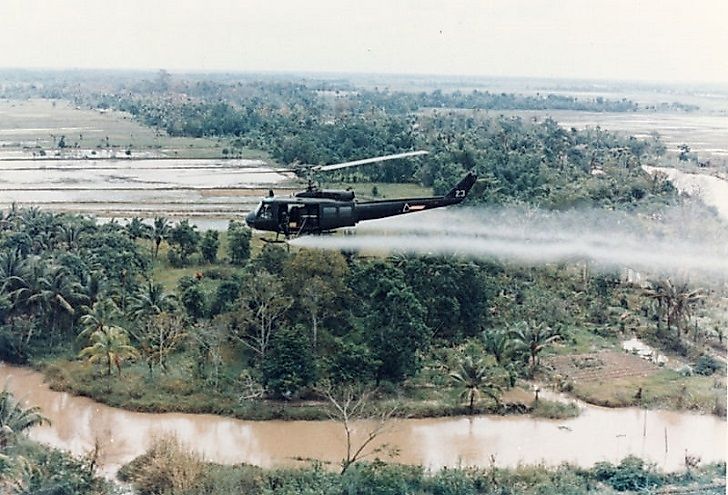What Are Defoliants Used For?

5. Defoliants versus Herbicides
Herbicides are chemicals that are sprayed on plants to destroy or inhibit their growth. Defoliants could be considered a type of herbicide, and ones which merely strip the leaves from plants. They open up a countryside hitherto covered with dense foliage. Herbicides and defoliants are mainly used in agriculture, forestry, industrial areas and lawns. Organic herbicides have been used for controlling weeds since the time of the ancient Greeks but the application was occasional with ambiguous results. From the 19th Century onward, inorganic herbicides were increasingly used in Europe, and later in North America. They consisted of metallic salts, such as sulfates of iron and copper, sodium arsenide, and copper nitrate.
4. Role in Warfare
Herbicidal warfare consists of destroying the plant-based ecology of an area. The main purpose is to disrupt the agriculture and destroy plants, which provide cover to the army. Herbicidal warfare does not come under the categories of ‘chemical warfare’ or ‘weapons of mass destruction. Britain was the first country to use herbicides in a military conflict in Malaya emergency in Malaysia in the early 1950s. They sprayed defoliants to deprive the communists of cover and targeted food crops to starve the insurgents. The British used Trioxone, which was similar to the Agent Orange used by the United States in the Vietnam War. Due to the environmental effects, herbicidal warfare has been banned by the Environmental Modification Convention since 1978.
3. Use in Agriculture
Defoliants are used in agriculture mainly to kill weeds. Weeds need to be eliminated for a number of reasons. Weeds also consume water and fertilizers and other resources, which better serve the food crops. Removing weeds also optimize the crop yield, as weeds compete for the soil nutrients and sunlight. If yields are low, food becomes expensive. If unchecked, some weeds can grow so big machinery may not be able to harvest a field. Inefficient harvesting can also reduce crop yield, which further affects the profitability of the farm. The most common herbicide used in agriculture is 2,4-D. It is toxic to many weeds, but not to food crops like wheat, maize, rice, or barley.
2. Application Methods
Defoliants are sprayed on or applied to the portion of the weeds above the ground, which are absorbed by plant tissue. The defoliants are called post-emergence herbicides and can be applied at numerous sites on the plant or at specific points. Some weeds have external barriers like waxes, cuticles and cell walls, which can affect the absorption, and therefore effectiveness of the chemical. Glyphosate, 2,4-D and dicamba are popular defoliants. Post-emergence herbicides have low residual activity and should not be applied during the rainy season. Rains wash away the chemical, effectively neutralizing the application. Defoliants are typically applied as water-based sprays with ground equipment. Equipment with long booms enables large areas to be covered using self-propelled sprayers. The booms can be 60 to 120 feet (18 to 37 meters) long with spray nozzles every 20-30 inches apart. Defoliants are also applied aerially over large areas using helicopters or airplanes or with an irrigation system called ‘chemigation’.
1. Safety to Humans and the Environment

Defoliants have variable toxicity, which can become acute due to occupational exposure, causing a range of health issues from rashes to death. Herbicides can be consumed in a variety of ways from direct and indirect consumption. Research suggests that phenoxy herbicides contaminated with dioxins slightly increases risk of cancer. Triazine is implicated in an increased risk of breast cancer. Paraquat has been shown to increase the risk of Parkinson’s disease with extended or occupational exposure. Defoliant manufacturers sometimes make misleading claims about the safety of their chemicals. In the United States all organic and inorganic commercially sold herbicides have to be tested extensively for approval by the Environmental Protection Agency (EPA).











